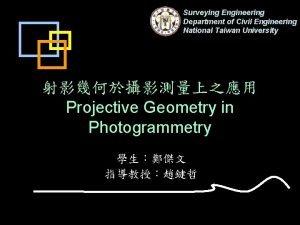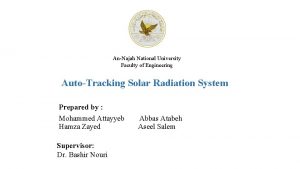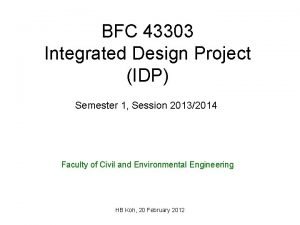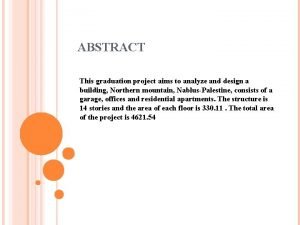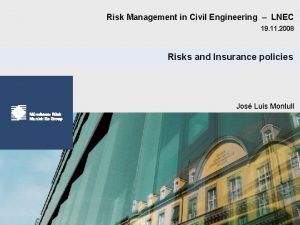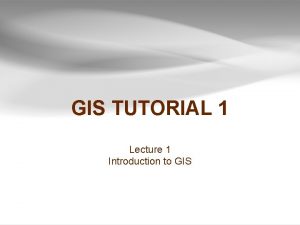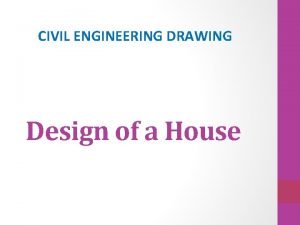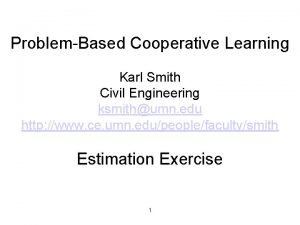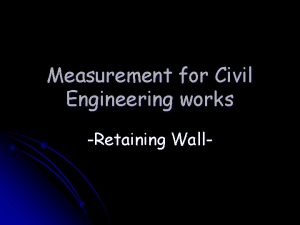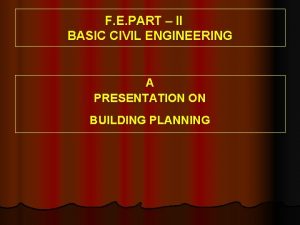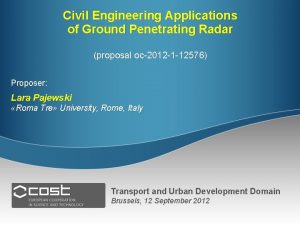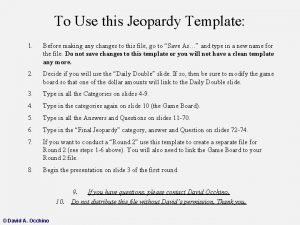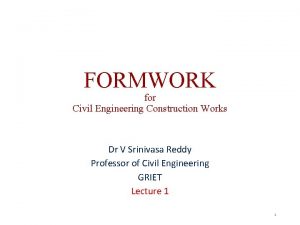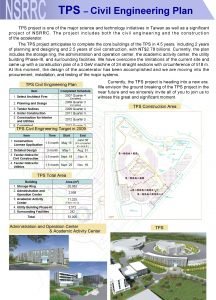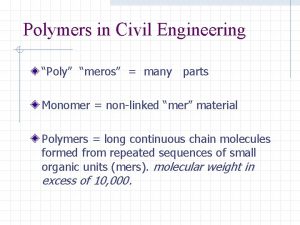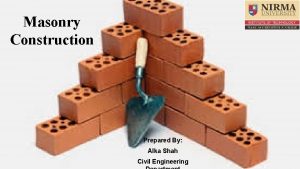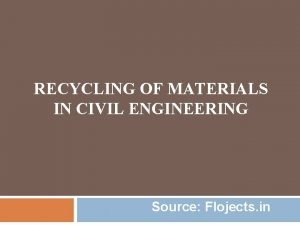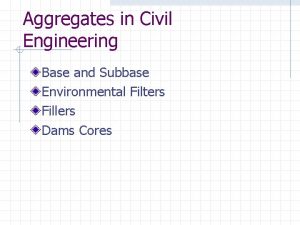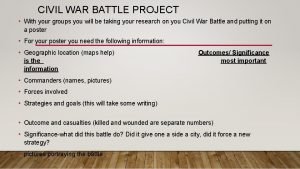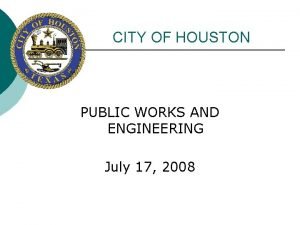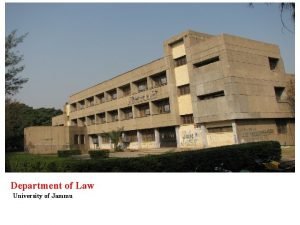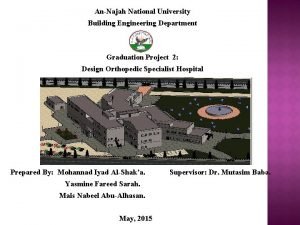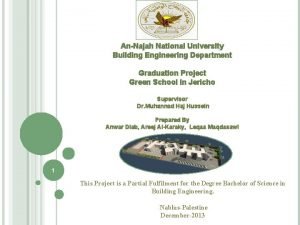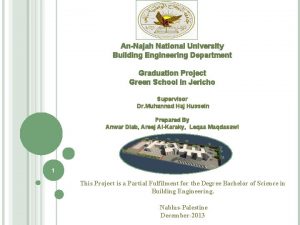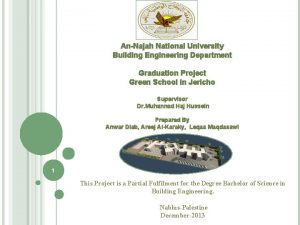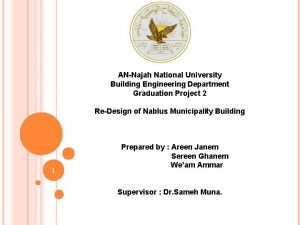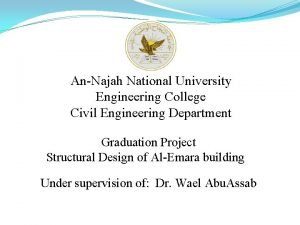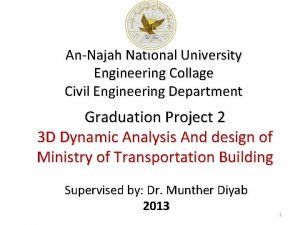AnNajah National University Civil Engineering Department Graduation Project















































































- Slides: 79

An-Najah National University Civil Engineering Department Graduation Project 3 -D Dynamic Structural Design For “Mecca Commercial” Building Prepared By: Samir Mizyed Muhammad Jarrar Osama Massarweh Osama Qashou Supervised by: Dr. Abd Al-Razaq Touqan

Table of contents: � Chapter � Chapter One: Abstract and Introduction Two: Preliminary Design Three: Static Design Four: Dynamic Analysis Five: Soil Structure Interaction


Chapter One: Abstract and Introduction a) The “Mecca Commercial Building” is located in Nablus city, consists of nine floors and will be used primarily as offices and commercial stores. b) The project will include a detailed design of all structural elements in the building such as slabs, beams and columns. c) It will include a 3 D-designed model for the whole building.

Methodology and Design Codes � � A 3 D static model will be used for analysis and design considering dead and live loads. Moreover, hand calculations will be used for some elements for verification of the model. In order to determine required loads and structural elements dimensions according to loads we will use these codes: a) ACI 318 -08 Code for design. b) IBC-2009 for loads. c) ASCE 7 -05, 2006 for minimum loads. �

Materials Concrete: For beams and slabs: compressive strength (f’c) = 28 MPa For columns: f’c = 35 MPa Unit weight of reinforced concrete = 24. 5 KN/ m 3. � Steel: Yielding strength (Fy) = 420 MPa Modulus of elasticity (E) = 200 GPa � Non structural elements: � Material Plain concrete Filler material Blocks Masonry stone Tiles Unit weight(KN/m 3) 23 17 12 27 27

Loads and Computer Programs: Super-imposed Dead Load = 4 KN/m 2 � Live Load = 3 KN/m 2 � Load combinations in ACI Code are: U 1=1. 4 D U 2=1. 2 D+1. 6 L � Computer Programs: For analysis and design processes we will use SAP 2000(version 14. 2. 4). �

Chapter Two: Preliminary Design � � In this chapter we will design structural elements of the building as a preliminary design. This design is based on determinants such as shear and bending. In this project, the slab system to be used is a one way ribbed slab with hidden beams.

� The figure below shows the distribution of beams, columns and shear wall (note: all shear walls are 0. 3 m thick):

Preliminary Design of Slab � � The thickness of the slab based on the most critical span and using the ACI code (table 9. 5(a)) was found to be 0. 34 m. The figure below shows the dimensions of the rib:

Preliminary Design of Slab � � � Rib own weight=3. 25 KNm. rib (6. 14 KNm 2 ) WD =O. W. +S. I. =6. 14+4=10. 14 KN m 2 WL =3 KN m 2 WU =1. 2 D+1. 6 L=17 KN m 2 WU =9 KN/m. rib

The column dimensions are as follows: Column No. of columns C 1 Section Name (On SAP) col 0. 3*0. 6 Depth (m) Width (m) 2 0. 3 0. 6 C 2 col 0. 3*1. 5 1 0. 3 1. 5 C 3 col 0. 5*0. 5 6 0. 5 C 4 col 0. 6*0. 3 2 0. 6 0. 3 C 5 col 0. 6*0. 6 3 0. 6 C 6 col 0. 7*0. 7 2 0. 7 C 7 col 0. 8*0. 3 1 0. 8 0. 3 C 8 col 1. 5*0. 3 4 1. 5 0. 3 C 9 col 1. 65*0. 3 4 1. 65 0. 3

The beams dimensions are as follows: Beam Section Name (On SAP) Depth (m) Width (m) B 1 Beam 0. 5*0. 34 0. 5 B 2 Beam 0. 4*0. 34 0. 4 B 3 Beam 0. 3*0. 34 0. 3 B 4 Beam 0. 8*0. 34 0. 8

Critical Strip for Slab � The location of the critical strip is as shown below:

1 D Analysis of Critical Strip Using SAP � The load distribution, shear and moment diagrams for the critical strip are as shown below:

Critical Beam � The location of the critical beam is as shown below:

1 D Analysis of Critical Beam Using SAP � The load distribution, shear and moment diagrams for the critical strip are as shown below:

SAP 3 D Analysis � Below is the 3 d model of the structure:

Preliminary Checks Compatibility: As shown below, the structure moves together: �

Preliminary Checks Equilibrium: Area of Slab = 462 m 2 Total live load from slab = 3 * 462 = 1386 KN Total superimposed dead load from slab = 4 * 462 = 1848 KN Total volume of structure = 210. 725 m 3 Total dead load = total volume* unit weight of concrete =210. 725*25=5268 KN From the table from SAP we see that we are okay. � Output. Case. Type Global. FX Global. FY Global. FZ KN KN KN 5078. 649 DEAD Lin. Static -2. 988 E-12 -6. 025 E-12 Si Lin. Static -2. 261 E-12 -3. 741 E-12 1847. 662 live Lin. Static -1. 69 E-12 -2. 734 E-12 1385. 747 ult 1 Combination -9. 114 E-12 -1. 619 E-11 10528. 769

Preliminary Checks Stress strain relationships: We take the middle span of our selected slab: �

Preliminary Checks Based on the moment on the span as shown: From our 1 d analysis (width of both beams on the edges is 0. 5 m): Wu. Ln 2/8 = 17 * (3. 2 -0. 5)2/8 = 15. 5 KN. m From 3 d analysis: (3. 5+25)/2 + 2. 2 = 16. 45 KN. m %error = (16. 45 -15. 5)/16. 45 = 5. 8% < 10%, this means we are okay.

Comparing 1 D with 3 D � � � From the SAP 3 d model we found that the results for shear and moment for both the selected beam and slab varied significantly. This tells us there are problems in the assumption made for 1 -d analysis (for example, we assumed that the flexural strength of the beams is very high, which is not the case, especially considering that these are hidden beams). Since our 3 -d model is much closer to reality then 1 -d we use the values we got from 3 -d analysis for the design of slabs, beams and columns.

Chapter Three: � Before designing for reinforcement we checked all the floors of the structure to make sure all the beams and columns were safe

Slab Design � Below is the distribution of the moment on the slab:

Slab Design We divided the slab into two different areas of reinforcement: � Area 1: a) Negative Moment: � d = 310 mm, bf = 530 mm, bw = 130 mm Mu- = 55 Kn. m/m (from SAP) Mu- = 55 * 0. 53 = 29. 2 KN. m (moment per rib) From these values we find that As = 264 mm 2/rib, which is greater than Asmin = 133 mm 2/rib, so we take it. Use 2 Ф 14 mm/rib. b) Positive Moment: Applying the same laws we get As = 160 mm 2/rib, so we use 2 Ф 12 mm/rib Area 2: a) Negative Moment: As = 374 mm 2/rib Use 2 Ф 16 mm/rib b) Positive Moment: Use 2 Ф 12 mm/rib �

Slab Design � The figure below shows the distribution of ribs on the slab:

Slab Design � Below is the reinforcements for sections A-A from the previous figure:

Beam Design � The figure below shows all the beams we are going to design for:

Beam Design � � We will take the beams on grid line N (the critical beams) as sample calculations. Below are the moment values for the beams:

Beam Design � The figure below shows the reinforcement for the selected beams:

Column Design � � First off we take the most critical column to check for slenderness. This is col 0. 3*0. 6 (the one with the smallest dimensions) located on grid line N. The figure below displays the moment distribution on the column: We found that K*Lu/r > 34 – 12(M 2/M 1), so we have a long column. From calculations: ρ = 0. 01, meaning the area of steel required is 1% of area gross This is the same for all other columns in the building, whether long or short.

Column Design � The table below shows reinforcement for various columns: Column Name (SAP) Width (mm) Depth (mm) Area (mm^2) Area of steel (mm^2) Longitudinal Reinforcement Stirrup Reinforcement C 1 col 0. 3*0. 6 300 600 1800 6φ20 1φ10200 mm C 2 col 0. 3*1. 5 300 1500 4500 18φ18 5φ10200 mm C 3 col 0. 5*0. 5 500 250000 2500 8φ20 2φ10200 mm C 4 col 0. 6*0. 3 600 300 1800 6φ20 1φ10200 mm C 5 col 0. 6*0. 6 600 360000 3600 12φ20 3φ10200 mm C 6 col 0. 7*0. 7 700 490000 4900 18φ18 5φ10200 mm C 7 col 0. 8*0. 3 800 300 2400 8φ20 2φ10200 mm C 8 col 1. 5*0. 3 1500 300 4500 18φ18 5φ10200 mm C 9 col 1. 65*0. 3 1650 300 4950 18φ18 5φ10200 mm

Column Design � Below is a sample of column reinforcement for column of dimensions 0. 3*0. 6:

Foundation Design � The figure below displays our proposed mat:

Foundation Design � Below are the dimensions of the mat and the reference points:

Foundation Design � To calculate the required depth we took the critical ultimate load from corner, edge and internal columns as well as shear walls (all of which are internal) as shown below: Service Load Ult. Load Depth Type (KN) (mm) Corner 1257 1572 792. 97 Edge 2724 3470 883. 60 Internal 3114 4009 633. 17 SW 5528 6980 835. 46 � � We will take the depth as 900 mm and the thickness of the mat as 1 m. We will then replace the fixed supports on SAP with a slab and springs to represent the mat and soil. This changed the loads on the columns slightly, but not enough to change the depth.

Foundation Design � We found the center of gravity (by dividing the area into rectangles and triangles) and the center of loading (by taking the load from each column on the mat) to be as follows:

Foundation Design � The table below shows the stress on the critical point which is less than the allowable stress (200 KN/m 2), so we are okay. �� KNm 2 Xp (m) Xg (m) Yp (m) Yg (m) ex (m) ey (m) P total (KN) A total (m 2) Mx (KN. m) My (KN. m) Ix (m^4) Iy (m^4)) Cx (m) Cy (m) Mx*Cx/Ix (KN/m 2) My*Cy/Iy (KN/m 2) (P/A) total (KN/m 2) Stress (KN/m 2) 15. 09 14. 96 8. 83 8. 84 0. 01 -0. 13 74695. 00 565. 36 845. 63 -9357. 66 15454. 05 44419. 40 8. 99 -15. 79 0. 49 3. 33 132. 12 135. 94

Foundation Design � Next we check for punching shear for all the critical columns: Type Corner Edge internal SW Ult. Load Depth Width Length Punch. Shear (KN) (mm) (m) width (m) length (m) 1472 767. 33 0. 3 1. 65 0. 75 3264 856. 97 0. 3 1. 5 1. 2 4027 634. 59 0. 7 1. 6 6893 830. 24 0. 3 4. 95 1. 2 2. 1 1. 95 1. 6 5. 85 Allowable load (KN) 2313. 53 4250. 40 7619. 76 9411. 06 Taking the corner column as a sample: ϕVc = 2313. 5 KN > Pu = 1472 KN � As we can see all the loads are less than the allowable, which means we are okay. � The depth required is 856 mm but we keep it 900 mm.

Foundation Design � For reinforcement we will take a critical vertical and horizontal strip. We found that in most locations a minimum reinforcement of 6φ20/m was enough.

Foundation Design The figures on this slide and the following show other options: 1) Removing the area below the driveway. This will save us concrete. Max stress = 187. 95 KN/m 2, so we are okay �

Foundation Design 2) Extending the mat to the left. Since the critical column was found to be an edge column we can extend the mat a 1 m distance on that side, so that the column becomes an internal column. This will reduce the required depth for the entire mat

Foundation Design 3) Removing a portion of the mat in the center. This is similair to option 1, but here the shape will be more symmetrical giving us less eccentricity and thereby reducing to stress, which will be 149 KN/m 2

Foundation Design 4) Four mat plan. So that one column won’t decide the entire depth, we will divide the foundation into four mats, each with a different depth (stress at critical point for all of them was found to be okay).

Foundation Design � � � Options 3 and 4 were found to be the best. Option 4 saved us the most concrete but option 3 is easier to implement in reality. It all depends on the desires of the owner, whether he wants to save cost or save time and effort. It should be noted that the reason we have only been looking at how much each option saves concrete is because in all cases we mostly use minimum steel reinforcement, meaning the amount of steel does not vary significantly between the different options.

Chapter Four: � � � So far, we’ve only designed for static loads, but buildings can also be subjected to dynamic loads in the form of earthquakes. In this chapter we will perform dynamic analysis for the structure using response spectrum function on SAP 14, while doing some hand calculation to make sure SAP is working properly. We will check the design of the structure to see if it is safe against earthquakes, adjusting the design if necessary.

SAP Verification � � We must make sure SAP is working properly. First we find how many modes needed to achieve a Modal Load Participation ratio of more than 90% in all 3 -directions to ensure reliability in the accuracy of the structure modal. This is achieved after 525 modes as shown in the table below: Output. Case Item Dynamic Text Percent MODAL UX 99. 1527 MODAL UY 97. 7255 MODAL UZ 90. 0665

SAP Verification � � � Next, we will calculate the period in the x-direction and then compare it to what we get from SAP. We will assume that the building is completely rigid. Therefore, on SAP we will make temporary changes in the building so that it can behave as rigid structure, because then we can take the slabs as lump masses. These assumptions include increasing slab thickness to 2 m (while adjusting the weight modifier so that the weight remains the same), making the beams very stiff and preventing torsion in columns and shear walls.

SAP Verification � � In our hand calculations we will take the building as a 1 D structure where the slabs masses are concentrated in one point and all the columns and shear walls for each floor are represented by one column with stiffness equal to the summation of the stiffness of all of them. Stiffness = 3 EIy/L 3 We find the total stiffness in the x-direction (Kx) to be 3128600 KN/m Note: for columns and shear walls that have a large width in the x-direction we will also have to add shear stiffness as well (AG/(1. 2 L))

SAP Verification � Next we will use the Kx calculated previously to find the deflection for each floor and the total period Tx of the structure as shown in the table below: ∆^2 (m^2) m*(∆^2) F*∆ 536. 46 Total Deflection ∆ n δ (m) 0. 00296 0. 00262 0. 00558 0. 00228 0. 00786 0. 0000087 0. 0000311 0. 0000618 0. 0047 0. 0167 0. 0331 3. 115 5. 875 8. 281 1053. 6 536. 46 0. 00195 0. 00981 0. 0000962 0. 0516 10. 331 5 1053. 6 536. 46 0. 00161 0. 01142 0. 0001303 0. 0699 12. 027 6 1053. 6 536. 46 0. 00127 0. 01269 0. 000161 0. 0864 13. 368 7 1053. 6 536. 46 0. 00094 0. 01362 0. 0001856 0. 0996 14. 354 8 1053. 6 536. 46 0. 00060 0. 01422 0. 0002023 0. 1085 14. 985 9 821. 1 418. 5 0. 00026 0. 01449 0. 0002098 0. 0878 11. 894 Sum 0. 5583 94. 231 Floor No. Force F (KN) Mass M (t) 1 2 3 1053. 6 4

SAP Verification Notes: 1)Force = ma. We take a as 0. 2 g. 2)For the first eight floors the weight will equal the slab plus half the weight of the columns and shear walls above and below it, while the for the top floor the weight will equal the slab plus half the weight of the columns below it. Therefore for the first eight floors we have F 1 = 1053. 6 KN and for the last floor we have F 2 = 821. 1 KN � Taking the second floor as a sample calculation: ∆1 = (8 F 1+F 2)/Kx = (8*1053. 6 + 821. 1)/ 3128601. 4 = 0. 00296 m δ 2 = (7 F 1+F 2)/Kx = 0. 00262 m ∆2 = ∆1 + δ 2 = 0. 00296 + 0. 00262 = 0. 00558 m �

SAP Verification � � � From SAP we found that mode 1 is primarily in the x-direction (Ux = 78%) and the period is 0. 6 seconds. This means we have an error of 20%. However, since this mode is not completely in the x-direction we will for practical reasons accept an error of 25%. We then removed the rigid assumptions on SAP and tried to calculate the actual Tx. Unfortunately we could not find any mode where the period is mainly in the x-direction.

Response Spectrum � � � Now that we can are certain of SAP, we can enter the response spectrum and perform a start/check design of structure. Given the type and location of the building we will take S 1 = 0. 2 seconds, Ss = 0. 5 seconds from seismic graphs of the middle east, the important factor I = 1 from IBC code and the response modification factor R = 3 (sway ordinary) fro ASCE code. Scale Factor = I*g/R = 1 * 9. 81/3 = 3. 27 We also enter the following load combinations: Ultimate 3 = 1. 2*(Dead + si) + 1. 4*(Equ-resp. X) + 1*Live Ultimate 4 = 1. 2*(Dead + si) + 1. 4*(Equ-resp. Y) + 1*Live �

Response Spectrum � From the base reactions table in SAP, we find that the total force resulted from the earthquake in the x-direction is 953 KN and from the y-direction is 1060 KN, which is approximately 1. 27% and 1. 4% respectively of the total service static load from the building (75000 KN) in the gravity direction. We can prove from hand calculations: %earthquake load (both directions) = SD 1/(R*T 1)*100% %earthquake load = 0. 1333/(3*2. 3788)*100% = 1. 86% � This is around the value we got from SAP in both cases, which means we are okay. �

Check of Structural Design � After performing a start/check design of structure we find that there are several beams, all on grid line N, that failed, so we increase their widths to 0. 8 m instead on 0. 5 m. We then find that we are okay:

Check of Structural Design Notes: � The reason why all of these beams highlighted in red are unsafe is because the shear stress due to shear force and torsion together exceeds the maximum allowed value. � We expect the cause as to why this happened is because the loads on these beams are quite large compared to other beams, as these are critical beams. � No failure occurred on the two beams on the right because these beams have much shorter spans and therefore take less load and moment.

Check of Structural Design � Next we check the slabs, columns and beams comparing the previous ultimate moment values we got when we only had dead and live loads (Ult 1 = 1. 4 DL + 1. 6 LL) to the values we got when we had dead, live and earthquake loads (we have Ultimate 3 = 1. 2 DL + 1. 4 ELx + 1 LL and Ultimate 4 =1. 2 DL + 1. 4 ELy + 1 LL ).

Check of Structural Design � � � First we take the slabs. For the bottom slab we see that the moment in general actually decreases slightly when there is an earthquake load: Static Load: Earthquake X: Earthquake Y:

Check of Structural Design � Checking for other slabs and columns, we see that it is the same case for all of them. The reason for that is because for load combinations, we reduced the factor for the live load from 1. 6 to 1 when there was an earthquake load, which was unable to make up for the difference. When there is no earthquake load: UL= 1. 2 DL + 1. 6 LL When there is an earthquake load: UL = 1. 2 DL + 1. 4 EL + 1 LL (we got these equations from the AC 1 code) � � � This shows that a safe design against static loads can also result is a safe design against earthquakes. For beams, on the higher up floors we needed additional reinforcement on the edge beams, due to the high deflection in the columns increasing the moment of these beams. The rest of the beams remained the same.

New Design for Structure � A problem in our previous design was for mode 1 it was mainly under torsion, which we are uncertain of. To remove torsion we suggested to add shear walls in the corners as shown below:

New Design for Structure � This meant that for the fundamental mode, the torsion was reduced significantly, meaning we are more certain of the structural safety. We found though that a cantilever beam on floors 4 -roof was unsafe so we increased the width to 0. 8 meters:

New Design for Structure � � Another beam on floor 9 also needed an increase in width (to 0. 8 m). This is expected as it is a critical beam: The reason why the beam below it didn’t need adjustment, despite also being a critical beam of similar length is because it is now being carried on a shear wall.

Chapter Five: Soil Structure Interaction � � It is a traditional approach to assume infinite rigidity for supports when analyzing and designing the elements of super -structure. It is also traditional to assume infinite rigidity for superstructure when analyzing and designing the Foundation system.

Sub-grade models � Sub-grade models are mathematical models used to investigate SSI problems and to understand soil behavior under applied loads. Model Winkler's Hypothesis Filonenko-Borodich Pasternak's Hypothesis Pasternak's and Loof's Hypothesis Haber-Schaim Hetényi Rhines Assumptions Springs deformed, pretensioned membrane + springs shear layer + springs + shear layer + springs plate + springs + plate + shear layer + springs

Winkler’s Model: � � This is the oldest, simplest and most well known model used for SSI analysis by structural engineers. It consists of an infinite number of springs on a rigid base.

Analysis of Beam Supported by Springs � The figure below shows the 1 D model for the mat:

Analysis of Beam Supported by Springs � The beam has a height of 0. 5 m and a width of 0. 3 m as shown

k spring/K Beam k beam k spring R 1 R 2/R 1 R 1/W 0. 00001 4317 0. 04317 40 40 1 0. 333 0. 023 4317 99. 291 41. 04 39. 48 0. 96 0. 342 0. 05 4317 215. 85 42. 19 38. 91 0. 92 0. 352 0. 1 4317 431. 7 44. 13 37. 94 0. 86 0. 368 0. 2 4317 863. 4 47. 39 36. 31 0. 77 0. 395 0. 3 4317 1295. 1 50. 02 34. 99 0. 7 0. 417 0. 4 4317 1726. 8 52. 19 33. 91 0. 65 0. 435 0. 5 4317 2158. 5 54. 02 32. 99 0. 61 0. 45 0. 6 4317 2590. 2 55. 57 32. 22 0. 58 0. 463 0. 7 4317 3021. 9 56. 91 31. 55 0. 474 0. 8 4317 3453. 6 58. 07 30. 97 0. 53 0. 484 0. 9 4317 3885. 3 59. 01 30. 52 0. 492 1 4317 60 30 0. 5 1. 1 4317 4748. 7 61. 18 29. 41 0. 48 0. 51 1. 3 4317 5612. 1 62. 19 28. 91 0. 46 0. 518 2 4317 8634 65. 44 27. 28 0. 42 0. 545 3 4317 12951 67. 97 26. 02 0. 38 0. 566 5 4317 21585 70. 39 24. 81 0. 35 0. 587 6 4317 25902 71. 06 24. 47 0. 34 0. 592 8 4317 34536 71. 95 24. 03 0. 33 0. 6 9 4317 38853 72. 25 23. 88 0. 33 0. 602 10 43170 72. 5 23. 75 0. 33 0. 604 1000000 4317 4. 317 E+09 74. 12 22. 94 0. 31 0. 618

Analysis of Beam Supported by Springs � Drawing the relationship between the internal/external beam reactions and the spring/beam stiffness we get the following graph: 1, 2 1 0, 8 R 2/R 10, 6 0, 4 0, 3300000 003 0, 2 0 0 5 Kspring/(12 El/L^3) 10 15

Analysis of Beam Supported by Springs From the graph we can conclude the following: 1 - The reactions (displacements) are equal when the ratio of spring over beam stiffness approaches zero. 2 - When the ratio of spring over beam stiffness approaches infinity springs behaves as pin supports (with no vertical displacement). 3 - When the ratio of spring over beam stiffness approaches infinity, R 2/R 1 approaches 0. 3 which we can get from the analysis of a beam of two equal spans with uniformly distributed load formulas as shown in Figure 5. 8 on the next page. 4 -The ratio (R 2/R 1) decreases as Ks/Kb increases. 5 - The internal spring takes a load that equals 60% of the total load on the beam (tributary area) when Ks/Kb equals around 10. 6 - Using Keq= Kst/(1 + (Kst/ Ks)) where Ks is soil stiffness and Kst is structural stiffness, when Ks is very large then equals 0, thus Keq=Kst. . �

Analysis of frame supported by springs: � � The same beam and the same methodology in section 5. 5 is used for frame analysis. The only difference is we now have columns of 3. 5 m height between the beams and springs as shown below: The table on the next slide shows the effect of spring stiffness on reactions and Moment in external column for column of dimension 0. 5*0. 3 m

Ks/Kb ratio 0. 023 0. 05 0. 1 0. 2 0. 3 0. 4 0. 5 0. 6 0. 7 0. 8 0. 9 1 1. 3 2 3 5 6 8 9 10 20 40 1000000 K beam 4317 4317 4317 4317 4317 4317 K spring 99. 291 215. 85 431. 7 863. 4 1295. 1 1726. 8 2158. 5 2590. 2 3021. 9 3453. 6 3885. 3 4317 4748. 7 5612. 1 8634 12951 21585 25902 34536 38853 43170 86340 172680 R 1 40. 35 40. 76 41. 47 42. 79 43. 99 45. 07 46. 06 46. 97 47. 08 48. 57 49. 28 49. 94 50. 55 51. 66 54. 61 57. 32 60. 34 61. 26 62. 55 63. 01 63. 4 65. 3 66. 37 R 2 39. 83 39. 62 39. 27 38. 61 38. 01 37. 47 36. 97 36. 52 36. 46 35. 72 35. 36 35. 03 34. 73 34. 17 32. 7 31. 34 29. 83 29. 37 28. 73 28. 5 28. 3 27. 35 26. 82 M(external ) 46. 46 45. 99 45. 15 43. 6 42. 2 40. 9 39. 7 38. 7 37. 7 36. 8 36 35. 23 34. 5 33 29. 7 26. 6 23. 01 21. 59 20. 4 19. 23 19. 04 17. 4 15. 9 R 2/R 1 0. 99 0. 97 0. 95 0. 9 0. 86 0. 83 0. 8 0. 77 0. 74 0. 72 0. 7 0. 69 0. 66 0. 55 0. 49 0. 48 0. 46 0. 45 0. 42 0. 4 R 1/W 0. 336 0. 346 0. 357 0. 367 0. 376 0. 384 0. 391 0. 392 0. 405 0. 411 0. 416 0. 421 0. 431 0. 455 0. 478 0. 503 0. 511 0. 525 0. 528 0. 544 0. 553 M/(WL 2/8) 1. 03 1. 02 1 0. 97 0. 94 0. 91 0. 88 0. 86 0. 84 0. 82 0. 8 0. 77 0. 73 0. 66 0. 59 0. 51 0. 48 0. 45 0. 43 0. 42 0. 39 0. 35 4317000000 67. 33 26. 34 14. 8 0. 39 0. 561 0. 33

Analysis of frame supported by springs: � � We do the same for columns of dimension 0. 7*0. 4 m. By drawing the relationship between the ratio of spring to beam stiffness and R 2/R 1 for (0. 5*0. 3)m and (0. 7*0. 4)m columns, we get the following graph: 1, 2 1 0, 8 R 2/R 10, 6 Column (0. 7*0. 5) 0, 4 Coulomn (0. 5*0. 3) 0, 2 0 0 10 20 Kspring/(12 El/L^3) 30 40 50

Analysis of frame supported by springs: � By drawing the relationship between the ratio of the spring to beam stiffness and M/(WL 2/8) for both (0. 5*0. 3)m and (0. 7*0. 4)m columns, we get the following graph: 70 M/(WL^2/8) 60 50 40 column (0. 7*0. 5) 30 20 column (0. 3*0. 5) 10 0 0 10 20 Kspring/(12 El/L^3) 30 40 50

Analysis of frame supported by springs: From the graphs we conclude the following: 1 - The reactions (displacements) are equal when the ratio of spring over beam stiffness approaches zero. The same behavior as the beam in 1 --D analysis. 2 - When the ratio of spring over beam stiffness approaches infinity springs behaves as Pin supports (with no vertical displacement). The same behavior as the beam in 1 -D analysis. 4 -The ratio (R 2/R 1) decreases as Ks/Kb increases. 5 - Larger cross section of the columns the ratio increases. 6 - As the ratio of spring over beam stiffness increases , the moment on the external columns decreases. 7 - As the cross section of the columns increases , the moment on the external columns increases.

Results and Conclusions: 1 - We can use Keq = Kst/(1 + (Kst/ Ks)) on the assumption that the soil and the structure are two springs connected in series, where Kst is the structure stiffness and Ksis the soil stiffness. 2 - If Ks is larger than Kst, then the equivalent stiffness Keq is equal to Kst, thus it is acceptable in this case to assume infinite rigidity for supports when analyzing and designing the elements of super-structure (Slab, beams and columns). 3 - If we have weak soil, Keq will be affected by the soil, thus to assume infinite rigidity for supports when analyzing and designing the elements of super-structure (Slab, beams and columns) would not be accurate molding. 4 - Assuming that the structure is divided into sub-structure and super-structure the same analogy can be used in analysis if having a conferrable mat such as what we have in our project.


Dedication To our beloved parents who devote their lives for us, To our friends who supported us, To our colleagues who did not hesitate to provide their assistance, To our dedicated teachers whom we are grateful for, To the AN-NAjah National University, the foster of advancement and knowledge, We would like to thank our dedicated supervisor Dr. Abd Al-Razaq Touqan who guided us and with his help we were able to update and enrich our knowledge and study.
 Ntu ce
Ntu ce Panti asuhan annajah
Panti asuhan annajah Logo annajah
Logo annajah Annajah motors
Annajah motors Annajah motors
Annajah motors Czech technical university in prague civil engineering
Czech technical university in prague civil engineering Czech technical university in prague civil engineering
Czech technical university in prague civil engineering Integrated design project civil engineering
Integrated design project civil engineering Department of information engineering university of padova
Department of information engineering university of padova Information engineering padova
Information engineering padova University of sargodha engineering department
University of sargodha engineering department Civil rights and civil liberties webquest
Civil rights and civil liberties webquest Arjun karanam
Arjun karanam High school graduation powerpoint template
High school graduation powerpoint template Graduation project report example
Graduation project report example Abstract for graduation project
Abstract for graduation project Introduction for graduation project
Introduction for graduation project Graduation project documentation
Graduation project documentation Graduation project documentation
Graduation project documentation Graduation project presentation
Graduation project presentation Final project bachelor degree
Final project bachelor degree National civil defence college
National civil defence college Civil air patrol national conference
Civil air patrol national conference Cven4102
Cven4102 Hse in civil engineering
Hse in civil engineering Civil engineering completed risks
Civil engineering completed risks Applications of grouting
Applications of grouting What is formwork in civil engineering
What is formwork in civil engineering Introduction to civil engineering
Introduction to civil engineering Role of civil engineering
Role of civil engineering Gis applications in civil engineering
Gis applications in civil engineering House civil engineering drawing
House civil engineering drawing Bisection method application in civil engineering
Bisection method application in civil engineering Umn civil engineering
Umn civil engineering Ndsu industrial engineering
Ndsu industrial engineering Retaining wall in civil engineering
Retaining wall in civil engineering Building control line
Building control line Civil engineering applications of ground penetrating radar
Civil engineering applications of ground penetrating radar Civil engineering faculty
Civil engineering faculty Ub mae flowsheet
Ub mae flowsheet Cuban american association of civil engineers
Cuban american association of civil engineers Branch of civil engineering
Branch of civil engineering Cement ph value
Cement ph value Rtei
Rtei In civil engineering
In civil engineering Lintel formwork
Lintel formwork Eol jsc nasa gov
Eol jsc nasa gov Tps civil engineering
Tps civil engineering Civil engineering works
Civil engineering works Advantages and disadvantages of thermoplastics
Advantages and disadvantages of thermoplastics Uh manoa civil engineering checklist
Uh manoa civil engineering checklist Racking back and toothing
Racking back and toothing Civil engineering source
Civil engineering source Bachelor of construction management swinburne
Bachelor of construction management swinburne Bsg civil engineering
Bsg civil engineering Cement chapter in civil engineering
Cement chapter in civil engineering Civil war trading cards project
Civil war trading cards project Civil war battle project
Civil war battle project Risk and resilience ambulance
Risk and resilience ambulance What are national core standards
What are national core standards Function of national audit department in malaysia
Function of national audit department in malaysia Electrical engineering department
Electrical engineering department Engineering department in hotel
Engineering department in hotel City of houston design manual
City of houston design manual Kpi for engineering department
Kpi for engineering department Tum
Tum Eacads iitd
Eacads iitd University of bridgeport computer science
University of bridgeport computer science Computer science tutor bridgeport
Computer science tutor bridgeport Computer engineering department
Computer engineering department Ucla electrical engineering department
Ucla electrical engineering department Department of law university of jammu
Department of law university of jammu Department of geology university of dhaka
Department of geology university of dhaka University of padova psychology
University of padova psychology University of bridgeport it department
University of bridgeport it department University of iowa math
University of iowa math Sputonik
Sputonik Texas state majors
Texas state majors Manipal university chemistry department
Manipal university chemistry department Syracuse university pool
Syracuse university pool
